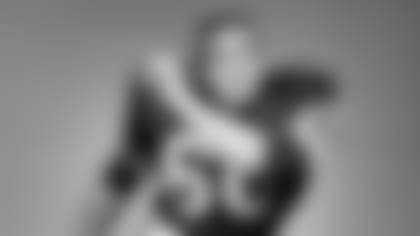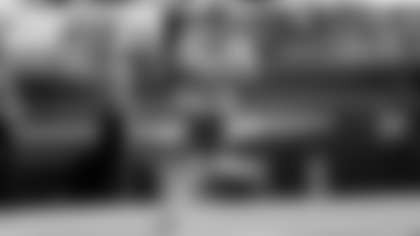Lee Roy Caffey
Inducted: 1986
Linebacker: 1964-69
Height: 6-4; Weight: 240
College: Texas A&M, 1960-62
HONORS:
- Associated Press All-Pro Team (chosen since 1940): 1966
- Pro Bowl Selection (game played since 1950): 1965
Few in the Packers' talented pool of outside linebackers dating to the Lombardi era were more physically gifted than Lee Roy Caffey. Before growing into a 6-foot-4, 240-pound NFL linebacker, he was fast enough to have been the leading rusher as a junior at Texas A&M. Playing for the Aggies during the one-platoon era of college football, Caffey doubled as a fullback and linebacker. He also was credited with running a 10-flat 100-yard dash.
Along with having the speed to play man coverage on halfbacks swinging out of the backfield during his six seasons with the Packers, Caffey also had the strength to fend off blockers and turn runs back to the inside. In assistant coach Phil Bengtson's defensive scheme, those were the primary responsibilities of the right linebacker. Although Caffey usually lined up to the offense's weak side, the Packers rarely blitzed under Bengtson.
It was Caffey's natural talent that allowed him to play a key role on defenses that ranked third, third and first in yards allowed as the Packers won three straight NFL championships under Vince Lombardi from 1965 to 1967.
On the other hand, the finer points of Caffey's game didn't always measure up. Backup Tommy Crutcher was a smarter, more reliable player, according to defensive line coach Dave Hanner, and there were those on the staff who thought the defense would have been better with him in the lineup. Instead, the Packers went with talent over intangibles and Crutcher would school Caffey on the sidelines between series. Personnel director Pat Peppler said Caffey was a big hitter, but not a fundamentally sound tackler. In addition, Peppler said Bengtson complained about Caffey's pass drops. Secondary coach Norb Hecker said Caffey also frustrated Lombardi to no end. "He and Vince never got along," said Hecker. "They clashed an awful lot. Whether, he was arrogant with Vince or what, they rubbed each other the wrong way. But he was a good player. He could run like heck."
In the 1966 season opener, Caffey intercepted a John Unitas pass in the second quarter and returned it 52 yards for a touchdown to spark a 24-3 victory over the Baltimore Colts, who had tied the Packers for the Western Conference title the season before. In 1965, Caffey returned an interception 42 yards for a touchdown as the Packers beat the Chicago Bears, 23-14.

If there was one game that might have been a microcosm of Caffey's career, it was the Ice Bowl.
He made three of the biggest defensive plays of the game, all in the third quarter and all on plays that prevented Dallas from scoring after it had moved well into Green Bay territory. Caffey dropped halfback Dan Reeves for a 4-yard loss on first-and-10 from the Packers' 18-yard line, forced a fumble that was recovered by cornerback Herb Adderley at the Packers' 13 and dropped quarterback Don Meredith for a 9-yard loss on third-and-5 from the Packers' 30. At the same time, Caffey was largely at fault for the 50-yard option pass from Reeves to flanker Lance Rentzel that gave the Cowboys a 17-14 lead on the first play of the fourth quarter and nearly cost the Packers the game. While cornerback Bob Jeter took blame for the play, Caffey was the one who was supposed to get a deep drop and be in position to play the ball based on how the Packers prepared for the option pass during practice the week before the game.
"He was the fastest linebacker in the group," said Dave Robinson, who played outside linebacker opposite Caffey. "(Ray) Nitschke was the slowest. And Caffey was the biggest of the three. Lee Roy was the best blitzer. But he had mental lapses. Lee Roy was good, but he didn't play his best all the time."
The Packers acquired Caffey on May 5, 1964, in a trade with the Philadelphia Eagles. The Packers received Caffey, who had played one year with the Eagles, and a first-round draft choice for center Jim Ringo and fullback Earl Gros. "We fell down a little bit on defense and we had to help it," Lombardi said of the trade. "Caffey has great speed and he was good enough to play regular in his first year."
In the third game of his first season with the Packers, Caffey replaced an injured Robinson as the starting right linebacker and held the job for six seasons, missing only one game with a sprained ankle in 1967. Caffey played in 83 regular-season games for the Packers and started 80, including two at middle linebacker for an injured Nitschke in 1965. In fact, there were some in the Packers organization who thought middle linebacker might have been a better position for Caffey. "Actually, he played better at middle linebacker than he did outside," said Peppler. "As a middle linebacker, he could fill a hole and he had the weight and the speed." Caffey also started seven postseason games, intercepted nine passes with the Packers and also briefly handled their kickoff duties early in his career.
Caffey asked to be traded following the 1969 season and his wish was granted. On Jan. 21, 1970, he was shipped to the Chicago Bears along with running back Elijah Pitts and offensive lineman Bob Hyland in exchange for the second pick in that year's NFL Draft. Caffey played one year with the Bears, then six games for Dallas in 1971 and 12 games for San Diego in 1972.
Born June 3, 1941, in Thorndale, Tex. Given name Lee Roy Caffey. Died Jan. 18, 1994, at age 52.
Lee Roy Caffey
- By Cliff Christl






